Stability of Inhaled Ciprofloxacin-Loaded Poly(2-ethyl-2-oxazoline) Nanoparticle Dry Powder Inhaler Formulation in High Stressed Conditions
Abstract
1. Introduction
2. Results and Discussion
2.1. Particle Size and Size Distribution
2.2. Moisture Content on Loss-on-Drying
2.3. Morphology Analysis of Stored Samples by Scanning Electron Microscopy (SEM) and Transmission Electron Microscopy (TEM)
2.4. Powder X-ray Diffraction: Solid-State
2.5. Thermal Analysis
2.6. Attenuated Total Refection-Fourier Transform Infrared (ATR-FTIR)
2.7. In Vitro Aerosol Performance
3. Materials and Methods
3.1. Materials
3.2. Preparation of Blank PEtOx NPs
3.3. Preparation of CIP-Loaded PEtOx NPs
3.4. Determination of Moisture Content
3.5. Stability Assessment
3.6. Morphology Investigation
3.7. Powder X-ray Diffraction (PXRD)
3.8. Thermal Analysis
3.9. Attenuated-Total Refection-Fourier Transform Infrared (ATR-FTIR)
3.10. In Vitro Aerosol Performance of the Stored Samples
3.11. Quantitative Analysis of CIP by High-Performance Liquid Chromatography (HPLC) Method
3.12. Statistical Analysis
4. Conclusions
Author Contributions
Funding
Institutional Review Board Statement
Informed Consent Statement
Data Availability Statement
Acknowledgments
Conflicts of Interest
References
- Sabuj, M.Z.R.; Islam, N. Inhaled antibiotic-loaded polymeric nanoparticles for the management of lower respiratory tract infections. Nanoscale Adv. 2021, 3, 4005–4018. [Google Scholar] [CrossRef]
- Shetty, N.; Cipolla, D.; Park, H.; Zhou, Q.T. Physical stability of dry powder inhaler formulations. Expert Opin. Drug Deliv. 2020, 17, 77–96. [Google Scholar] [CrossRef] [PubMed]
- Johnson, K.L.; Kendall, K.; Roberts, A.D. Surface energy and the contact of elastic solid. Proc. R. Soc. A 1971, 324, 301–313. [Google Scholar]
- Padmadisastra, Y.; Kennedy, R.A.; Stewart, P.J. Solid bridge formation in sulfonamide-Emdex interactive systems. Int. J. Pharm. 1994, 112, 55–63. [Google Scholar] [CrossRef]
- Coelho, M.C.; Harnby, N. Moisture bonding in powders. Powder Technol. 1978, 20, 201–205. [Google Scholar] [CrossRef]
- Hoppentocht, M.; Akkerman, O.W.; Hagedoorn, P.; Frijlink, H.W.; de Boer, A.H. The Cyclops for pulmonary delivery of aminoglycosides; a new member of the Twincer™ family. Eur. J. Pharm. Biopharm. 2015, 90, 8–15. [Google Scholar] [CrossRef]
- Benke, E.; Farkas, A.; Szabo-Revesz, P.; Ambrus, R. Development of an innovative, carrier-based dry powder inhalation formulation containing spray-dried meloxicam potassium to improve the in vitro and in silico aerodynamic properties. Pharmaceutics 2020, 12, 535. [Google Scholar] [CrossRef]
- Ingvarsson, P.T.; Yang, M.; Nielsen, H.M.; Rantanen, J.; Foged, C. Stabilization of liposomes during drying. Expert Opin. Drug Deliv. 2011, 8, 375–388. [Google Scholar] [CrossRef] [PubMed]
- Ye, T.; Yu, J.; Luo, Q.; Wang, S.; Chan, H.-K. Inhalable clarithromycin liposomal dry powders using ultrasonic spray freeze drying. Powder Technol. 2017, 305, 63–70. [Google Scholar] [CrossRef]
- Khatib, I.; Ke, W.-R.; Cipolla, D.; Chan, H.-K. Storage stability of inhalable, controlled-release powder formulations of ciprofloxacin nanocrystal-containing liposomes. Int. J. Pharm. 2021, 605, 120809. [Google Scholar] [CrossRef] [PubMed]
- Naini, V.; Byron, P.R.; Phillips, E.M. Physicochemical Stability of Crystalline Sugars and Their Spray-Dried Forms: Dependence upon Relative Humidity and Suitability for Use in Powder Inhalers. Drug Dev. Ind. Pharm. 1998, 24, 895–909. [Google Scholar] [CrossRef]
- Wu, L.; Miao, X.; Shan, Z.; Huang, Y.; Li, L.; Pan, X.; Yao, Q.; Li, G.; Wu, C. Studies on the spray dried lactose as carrier for dry powder inhalation. Asian J. Pharm. Sci. 2014, 9, 336–341. [Google Scholar] [CrossRef]
- Lin, Y.; Chang, R.Y.K.; Britton, W.J.; Morales, S.; Kutter, E.; Li, J.; Chan, H.-K. Storage stability of phage-ciprofloxacin combination powders against Pseudomonas aeruginosa respiratory infections. Int. J. Pharm. 2020, 591, 119952. [Google Scholar] [CrossRef] [PubMed]
- Shetty, N.; Park, H.; Zemlyanov, D.; Mangal, S.; Bhujbal, S.; Zhou, Q. Influence of excipients on physical and aerosolization stability of spray dried high-dose powder formulations for inhalation. Int. J. Pharm. 2018, 544, 222–234. [Google Scholar] [CrossRef] [PubMed]
- Momin, M.A.M.; Tucker, I.G.; Doyle, C.S.; Denman, J.A.; Das, S.C. Manipulation of spray-drying conditions to develop dry powder particles with surfaces enriched in hydrophobic material to achieve high aerosolization of a hygroscopic drug. Int. J. Pharm. 2018, 543, 318–327. [Google Scholar] [CrossRef] [PubMed]
- La Zara, D.; Sun, F.; Zhang, F.; Franek, F.; Balogh Sivars, K.; Horndahl, J.; Bates, S.; Braennstroem, M.; Ewing, P.; Quayle, M.J.; et al. Controlled Pulmonary Delivery of Carrier-Free Budesonide Dry Powder by Atomic Layer Deposition. ACS Nano 2021, 15, 6684–6698. [Google Scholar] [CrossRef]
- Sabuj, M.Z.R.; Dargaville, T.R.; Nissen, L.; Islam, N. Inhaled ciprofloxacin-loaded poly(2-ethyl-2-oxazoline) nanoparticles from dry powder inhaler formulation for the potential treatment of lower respiratory tract infections. PLoS ONE 2021, 16, e0261720. [Google Scholar] [CrossRef] [PubMed]
- Al-Qadi, S.; Grenha, A.; Carrión-Recio, D.; Seijo, B.; Remuñán-López, C. Microencapsulated chitosan nanoparticles for pulmonary protein delivery: In vivo evaluation of insulin-loaded formulations. J. Control. Release 2012, 157, 383–390. [Google Scholar] [CrossRef] [PubMed]
- Tong, X.; Pan, W.; Su, T.; Zhang, M.; Dong, W.; Qi, X. Recent advances in natural polymer-based drug delivery systems. React. Funct. Polym. 2020, 148, 104501. [Google Scholar] [CrossRef]
- Muhsin, M.D.A.; George, G.; Beagley, K.; Ferro, V.; Armitage, C.; Islam, N. Synthesis and Toxicological Evaluation of a Chitosan-l-Leucine Conjugate for Pulmonary Drug Delivery Applications. Biomacromolecules 2014, 15, 3596–3607. [Google Scholar] [CrossRef] [PubMed]
- Chiu, T.T.; Thill, B.P.; Fairchok, W.J. Poly(2-ethyl-2-oxazoline): A new water- and organic-soluble adhesive. Adv. Chem. 1986, 213, 425. [Google Scholar]
- Zhang, H.; Liu, X.; Xu, T.; Xu, K.; Du, B.; Li, Y. Biodegradable reduction and pH dual-sensitive polymer micelles based on poly (2-ethyl-2-oxazoline) for efficient delivery of curcumin. RSC Adv. 2020, 10, 25435–25445. [Google Scholar] [CrossRef] [PubMed]
- Koshkina, O.; Westmeier, D.; Lang, T.; Bantz, C.; Hahlbrock, A.; Würth, C.; Resch-Genger, U.; Braun, U.; Thiermann, R.; Weise, C.; et al. Tuning the Surface of Nanoparticles: Impact of Poly(2-ethyl-2-oxazoline) on Protein Adsorption in Serum and Cellular Uptake. Macromol. Biosci. 2016, 16, 1287–1300. [Google Scholar] [CrossRef] [PubMed]
- Su, T.; Zhao, W.; Wu, L.; Dong, W.; Qi, X. Facile fabrication of functional hydrogels consisting of pullulan and polydopamine fibers for drug delivery. Int. J. Biol. Macromol. 2020, 163, 366–374. [Google Scholar] [CrossRef] [PubMed]
- Wang, H.; George, G.; Bartlett, S.; Gao, C.; Islam, N. Nicotine hydrogen tartrate loaded chitosan nanoparticles: Formulation, characterization and in vitro delivery from dry powder inhaler formulation. Eur. J. Pharm. Biopharm. 2017, 113, 118–131. [Google Scholar] [CrossRef] [PubMed]
- Huang, Z.; Lin, L.; Mc Goverin, C.; Liu, H.; Wang, L.; Zhou, Q.; Lu, M.; Wu, C. Dry powder inhaler formulations of poorly water-soluble itraconazole: A balance between in-vitro dissolution and in-vivo distribution is necessary. Int. J. Pharm. 2018, 551, 103–110. [Google Scholar] [CrossRef]
- Choi, M.; Briancon, S.; Andrieu, J.; Min, S.; Fessi, H. Effect of freeze-drying process conditions on the stability of nanoparticles. Dry. Technol. 2004, 22, 335–346. [Google Scholar] [CrossRef]
- Wang, H.; George, G.; Islam, N. Nicotine-loaded chitosan nanoparticles for dry powder inhaler (DPI) formulations—Impact of nanoparticle surface charge on powder aerosolization. Adv. Powder Technol. 2018, 29, 3079–3086. [Google Scholar] [CrossRef]
- Gombas, A.; Szabo-Revesz, P.; Kata, M.; Regdon, G., Jr.; Eros, I. Quantitative Determination of Crystallinity of α-Lactose Monohydrate by DSC. J. Therm. Anal. Calorim. 2002, 68, 503–510. [Google Scholar] [CrossRef]
- Shah, B.; Kakumanu, V.K.; Bansal, A.K. Analytical techniques for quantification of amorphous/crystalline phases in pharmaceutical solids. J. Pharm. Sci. 2006, 95, 1641–1665. [Google Scholar] [CrossRef] [PubMed]
- Wang, H. Development of nicotine loaded chitosan nanoparticles for lung delivery. Ph.D. Thesis, Queensland University of Technology, Brisbane, Australia, 2017. [Google Scholar]
- Molina, C.; Kaialy, W.; Chen, Q.; Commandeur, D.; Nokhodchi, A. Agglomerated novel spray-dried lactose-leucine tailored as a carrier to enhance the aerosolization performance of salbutamol sulfate from DPI formulations. Drug Deliv. Transit. Res. 2018, 8, 1769–1780. [Google Scholar] [CrossRef] [PubMed]
- Eedara, B.B.; Rangnekar, B.; Doyle, C.; Cavallaro, A.; Das, S.C. The influence of surface active l-leucine and 1,2-dipalmitoyl-sn-glycero-3-phosphatidylcholine (DPPC) in the improvement of aerosolization of pyrazinamide and moxifloxacin co-spray dried powders. Int. J. Pharm. 2018, 542, 72–81. [Google Scholar] [CrossRef]
- Láng, P.; Kiss, V.; Ambrus, R.; Farkas, G.; Szabó-Révész, P.; Aigner, Z.; Várkonyi, E. Polymorph screening of an active material. J. Pharm. Biomed. Anal. 2013, 84, 177–183. [Google Scholar] [CrossRef] [PubMed]
- Cai, X.; Yang, Y.; Xie, X.; Yu, F.; Yang, Y.; Yang, Z.; Zhang, T.; Mei, X. Preparation, characterization and pulmonary pharmacokinetics of a new inhalable zanamivir dry powder. Drug Deliv. 2016, 23, 1962–1971. [Google Scholar] [CrossRef] [PubMed][Green Version]
- Young, P.M.; Sung, A.; Traini, D.; Kwok, P.; Chiou, H.; Chan, H.-K. Influence of Humidity on the Electrostatic Charge and Aerosol Performance of Dry Powder Inhaler Carrier based Systems. Pharm. Res. 2007, 24, 963–970. [Google Scholar] [CrossRef] [PubMed]
- Zhou, Q.; Gengenbach, T.; Denman, J.A.; Yu, H.H.; Li, J.; Chan, H.K. Synergistic Antibiotic Combination Powders of Colistin and Rifampicin Provide High Aerosolization Efficiency and Moisture Protection. AAPS J. 2014, 16, 37–47. [Google Scholar] [CrossRef] [PubMed]
- Ileleji, K.E.; Garcia, A.A.; Kingsly, A.R.P.; Clementson, C.L. Comparison of standard moisture loss-on-drying methods for the determination of moisture content of corn distillers dried grains with solubles. J. AOAC Int. 2010, 93, 825–832. [Google Scholar] [CrossRef]
- Momin, M.A.M.; Tucker, I.G.; Das, S.C. The influence of storage relative humidity on aerosolization of co-spray dried powders of hygroscopic kanamycin with the hydrophobic drug rifampicin. Drug Dev. Ind. Pharm. 2019, 45, 1205–1213. [Google Scholar] [CrossRef]
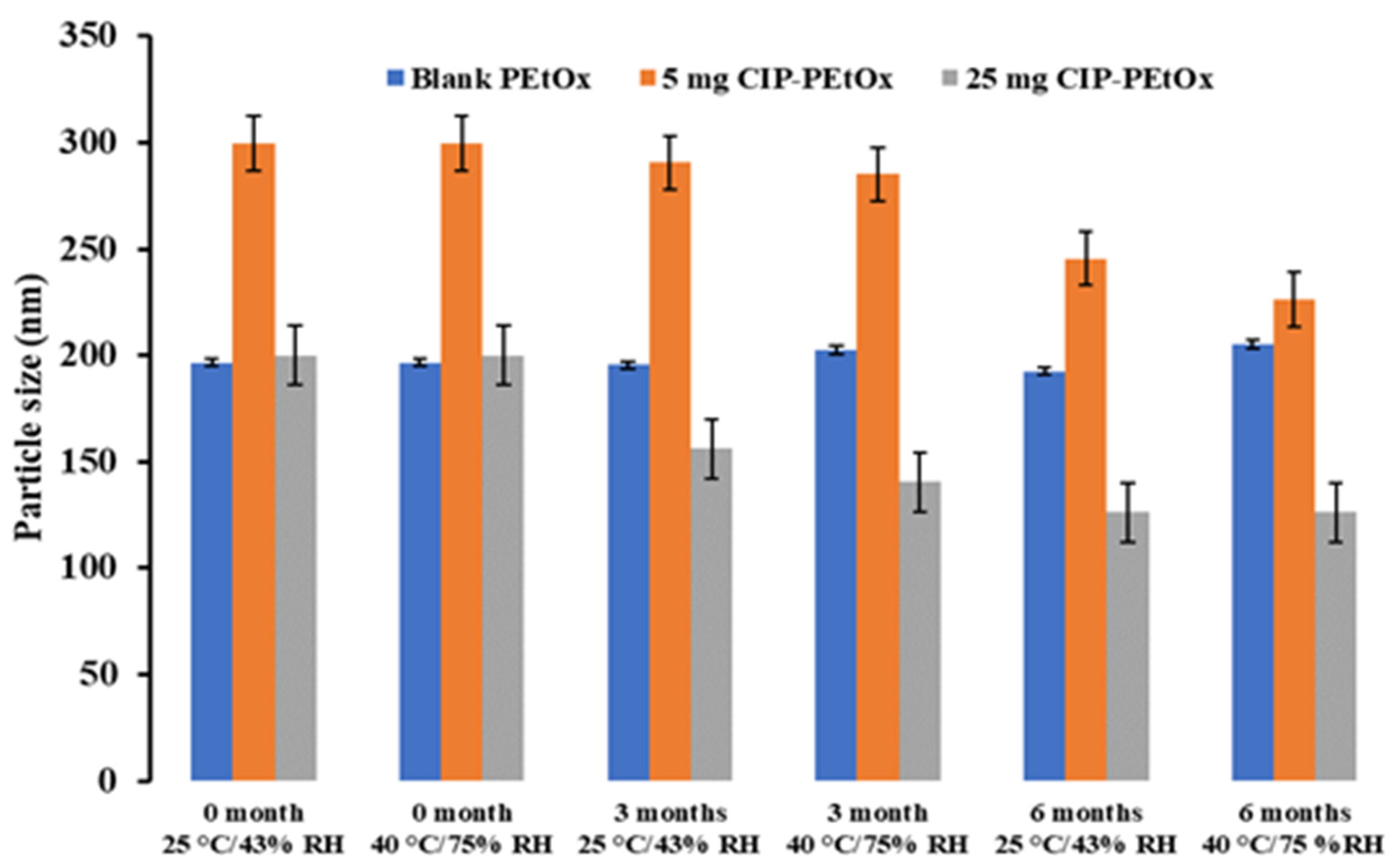
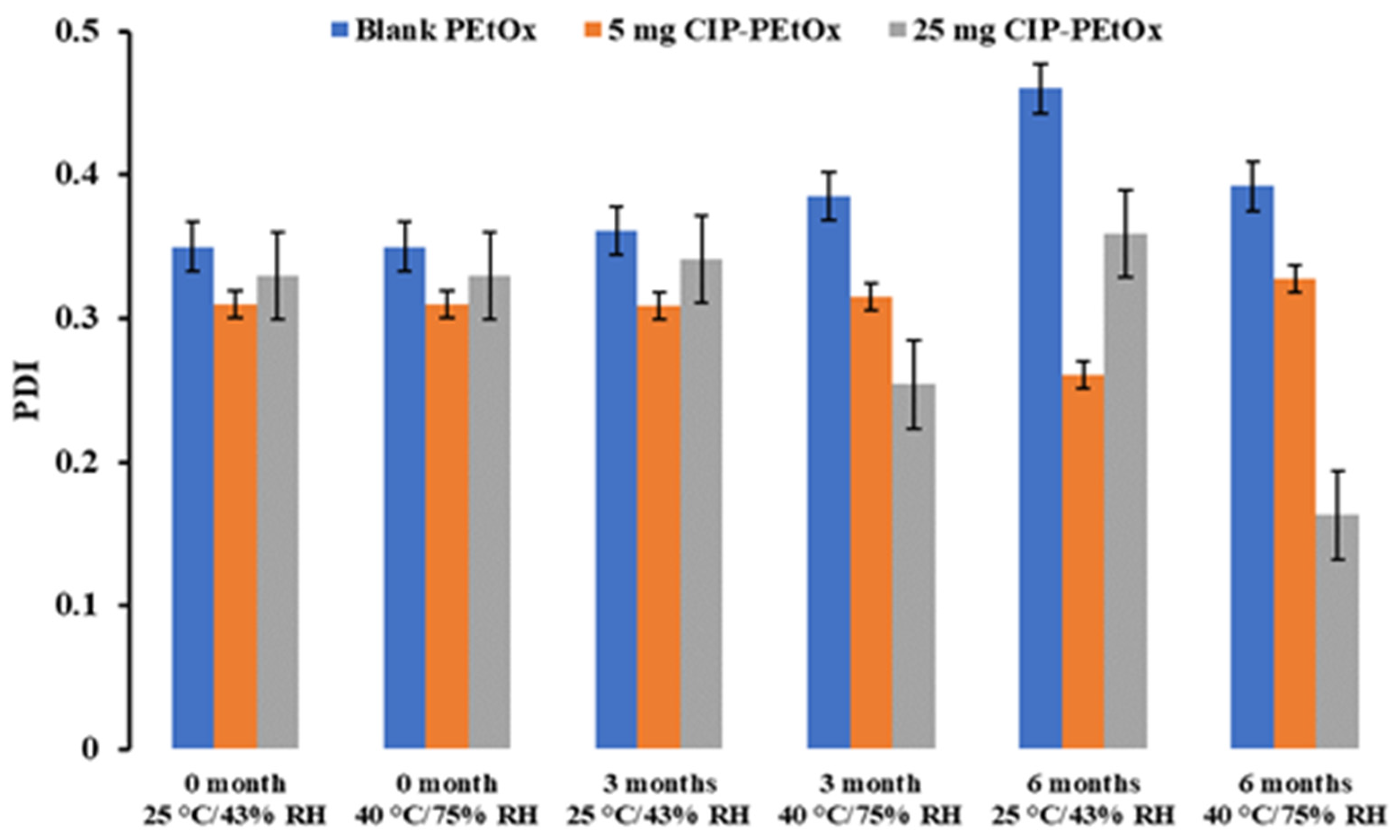
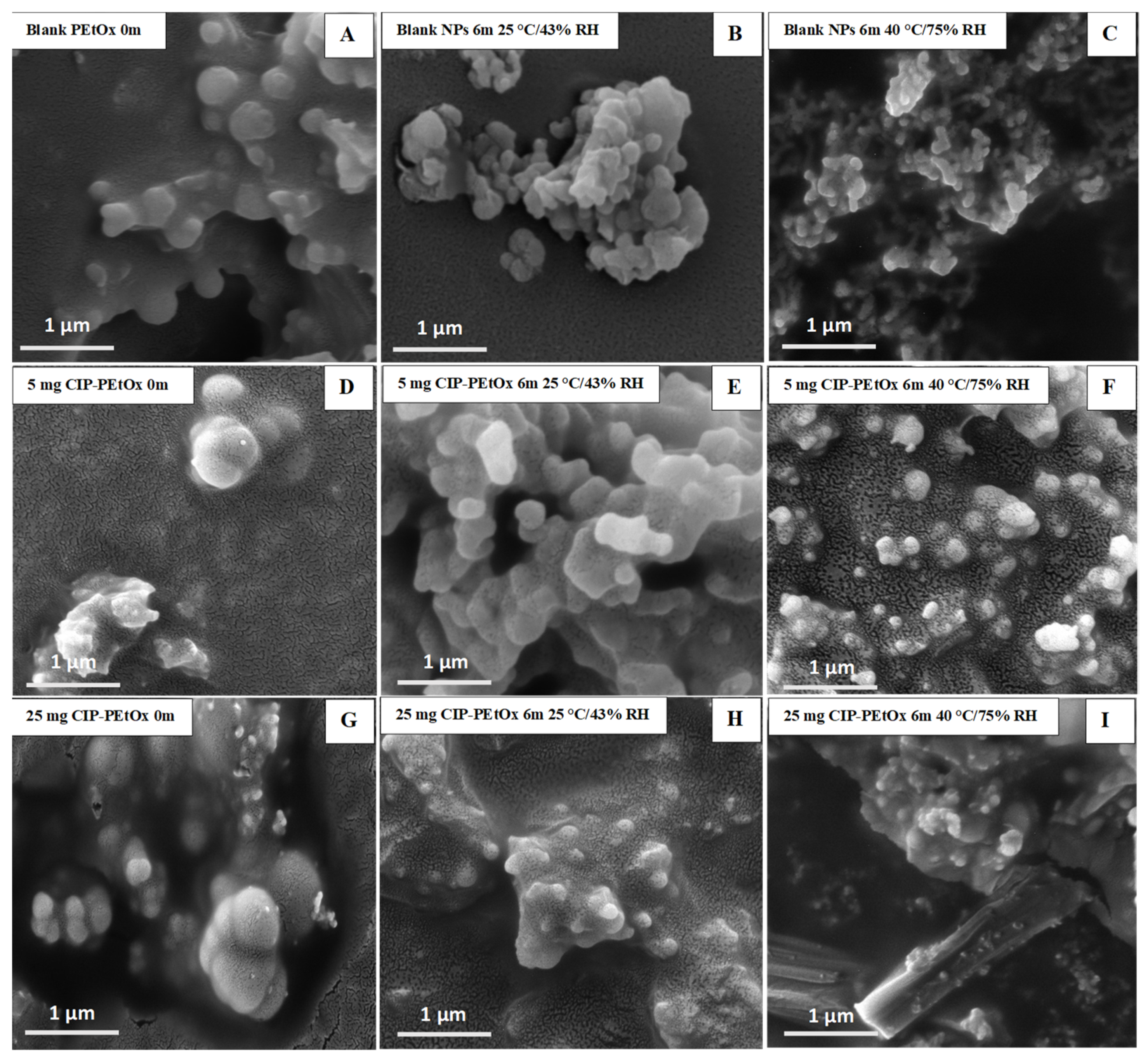
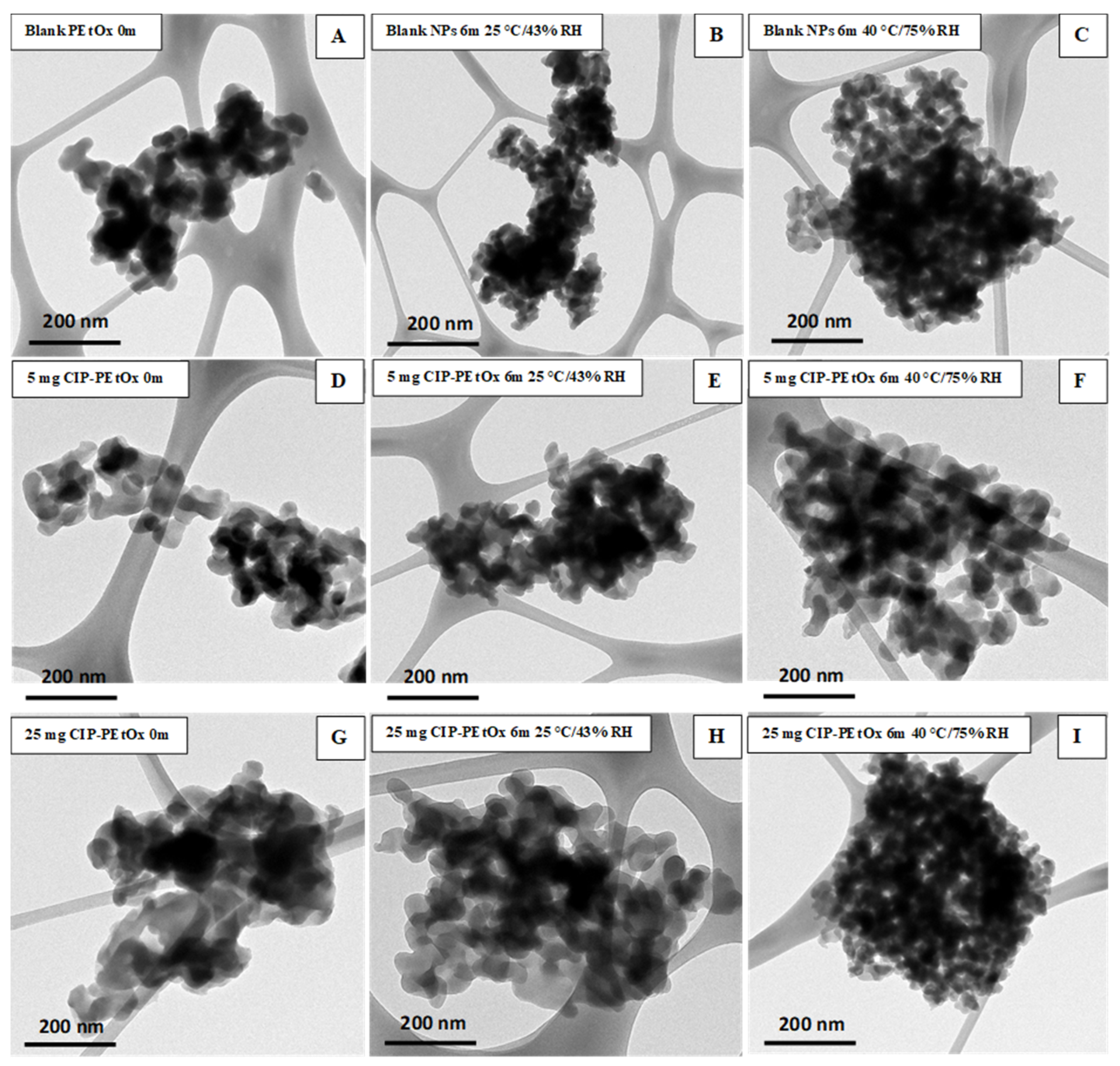

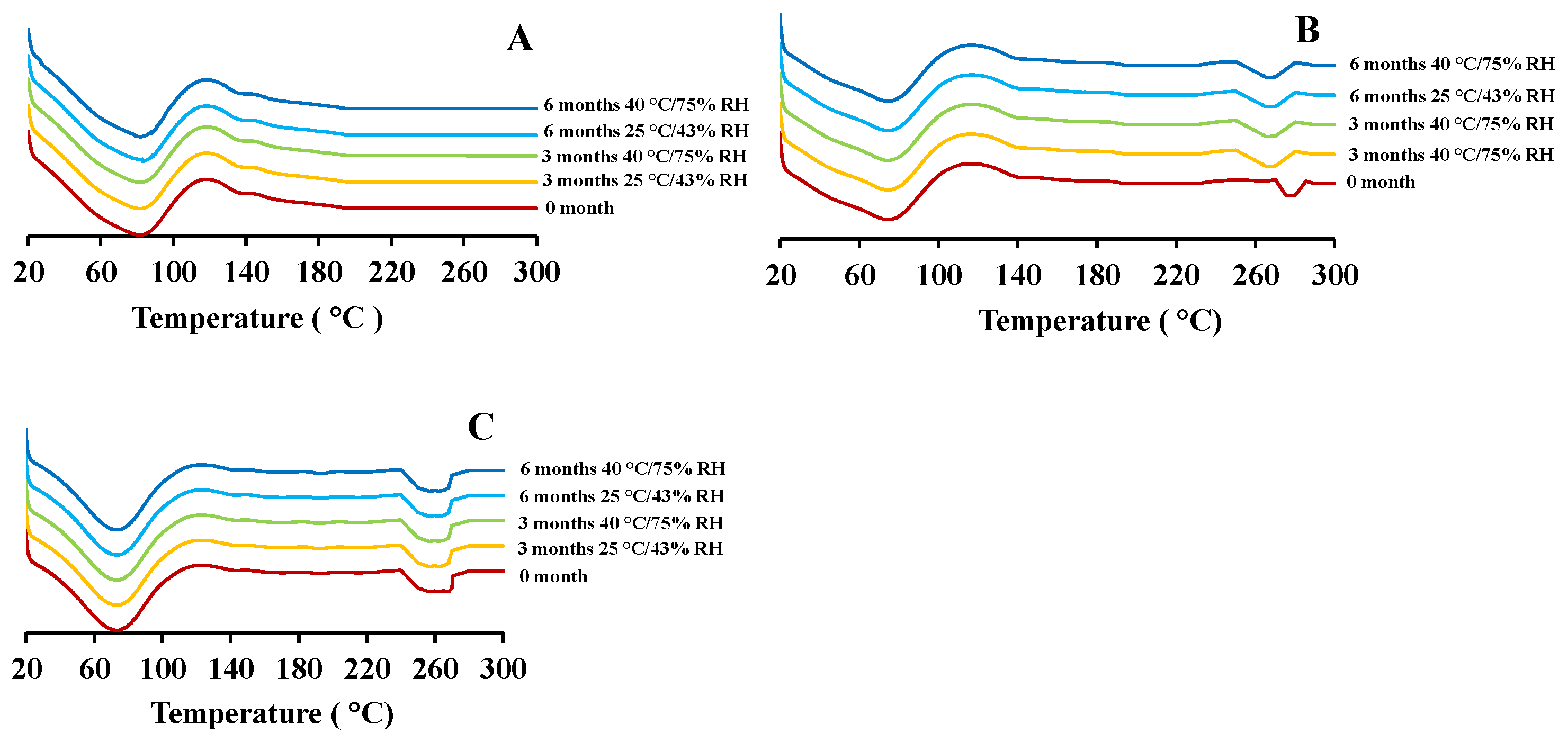
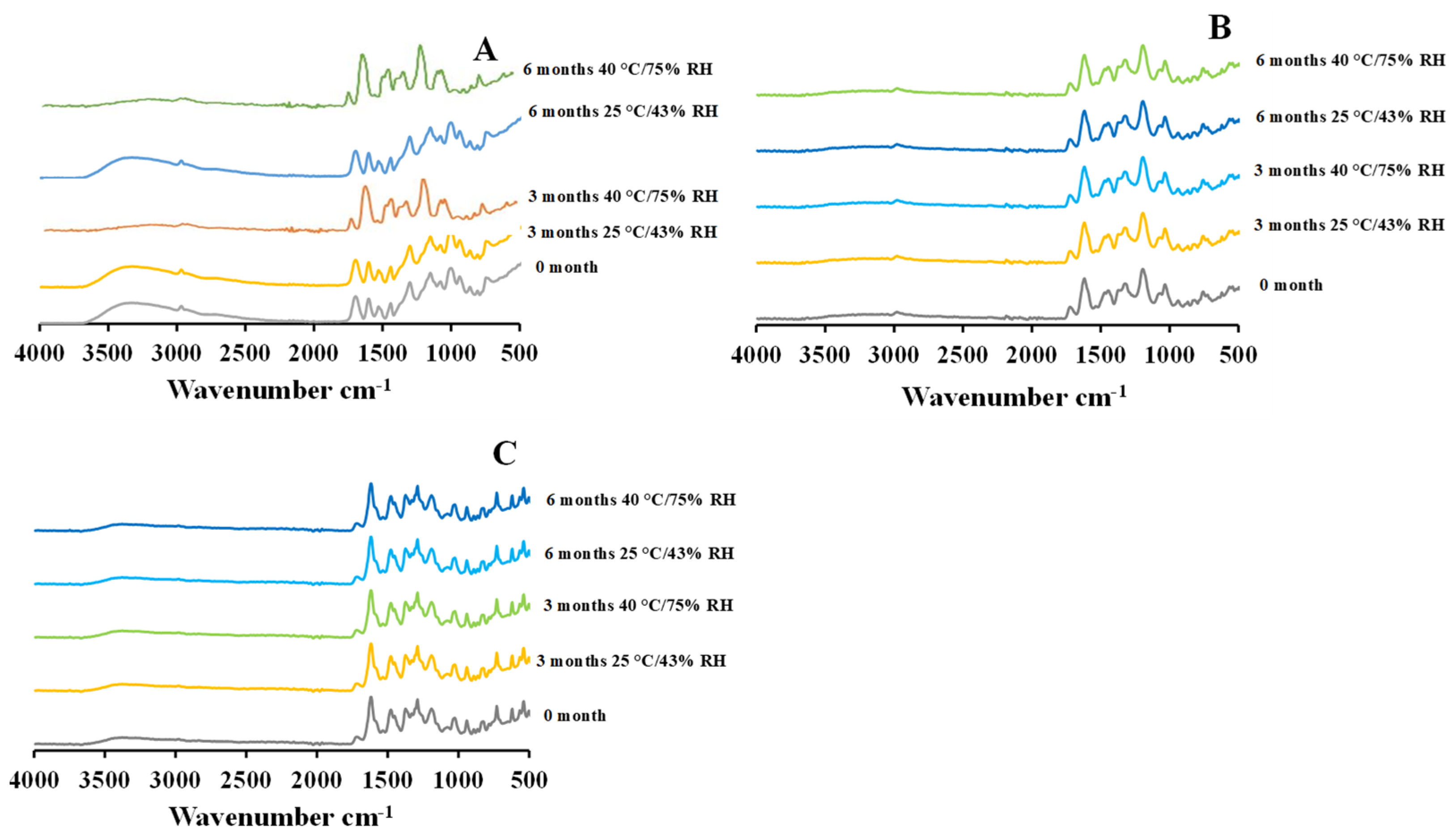
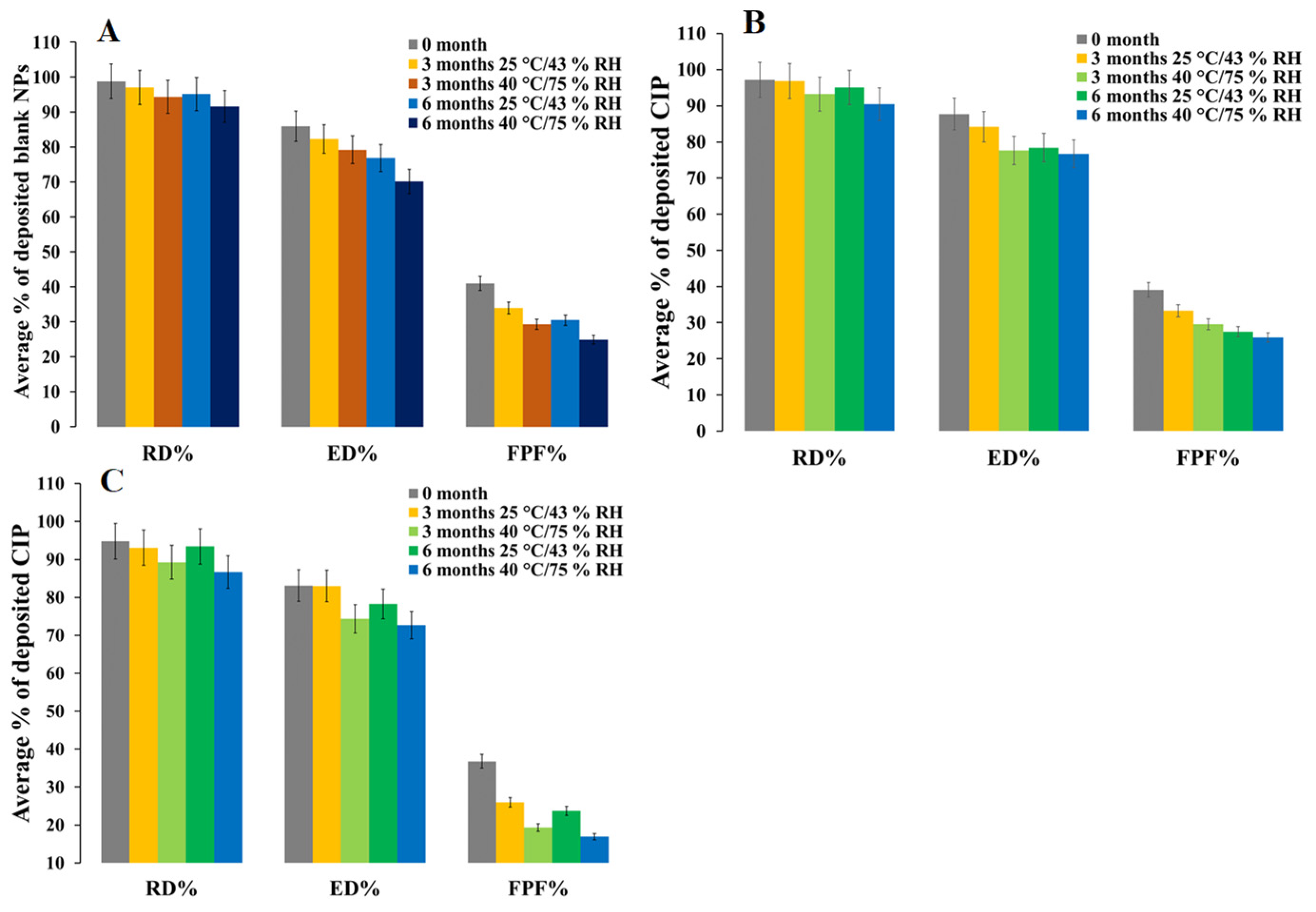
| Formulated NPs | Weight after 1 h | Weight after 2 h | Weight after 6 h | Weight after 12 h | Weight after 24 h |
|---|---|---|---|---|---|
| Blank PEtOx NPs | 492.2 ± 0.2 | 492.1 ± 0.1 | 492 ± 0.1 | 492 ± 0.1 | 492 ± 0.1 |
| 5 mg CIP-loaded NPs | 498.1 ± 0.3 | 498.1 ± 0.2 | 496.8 ± 0.4 | 496.7 ± 0.2 | 496.7 ± 0.1 |
| 25 mg CIP-loaded NPs | 498.4 ± 0.7 | 496.8 ± 0.8 | 495.8 ± 0.5 | 494.7 ± 1.7 | 494.7 ± 0.4 |
| Formulations | Storage Conditions | Storage Period | FPF (%) | FPD (mg) |
|---|---|---|---|---|
| Blank PEtOx NPs | 25 °C/43% RH | 3 | 32.3 ± 0.8 | - |
| 6 | 30.5 ± 2.4 | - | ||
| 40 °C/75% RH | 3 | 29.3 ± 0.7 | - | |
| 6 | 24.9 ± 2.0 | - | ||
| 5 mg CIP-loaded NPs | 25 °C/43% RH | 3 | 25.9 ± 1.9 | 0.6 ± 0.1 |
| 6 | 20.7 ± 2.1 | 0.5 ± 0.2 | ||
| 40 °C/75% RH | 3 | 19.3 ± 1.0 | 0.44 ± 1.1 | |
| 6 | 16.9 ± 3.1 | 0.4 ± 0.3 | ||
| 25 mg CIP-loaded NPs | 25 °C/43% RH | 3 | 33.3 ± 0.6 | 3.9 ± 0.6 |
| 6 | 27.5 ± 1.1 | 3.6 ± 0.1 | ||
| 40 °C/75% RH | 3 | 29.7 ± 1.5 | 3.4 ± 0.4 | |
| 6 | 25.9 ± 0.5 | 3.1 ± 0.1 |
| Formulated NPs | Amount of PEtOx (mg) | Amount of TA (mg) | Amount of CIP (mg) |
|---|---|---|---|
| Blank PEtOx NPs | 200 | 6 | - |
| 5 mg CIP-loaded NPs | 200 | 6 | 5 |
| 25 mg CIP-loaded NPs | 200 | 12 | 25 |
Publisher’s Note: MDPI stays neutral with regard to jurisdictional claims in published maps and institutional affiliations. |
© 2022 by the authors. Licensee MDPI, Basel, Switzerland. This article is an open access article distributed under the terms and conditions of the Creative Commons Attribution (CC BY) license (https://creativecommons.org/licenses/by/4.0/).
Share and Cite
Sabuj, M.Z.R.; Rashid, M.A.; Dargaville, T.R.; Islam, N. Stability of Inhaled Ciprofloxacin-Loaded Poly(2-ethyl-2-oxazoline) Nanoparticle Dry Powder Inhaler Formulation in High Stressed Conditions. Pharmaceuticals 2022, 15, 1223. https://doi.org/10.3390/ph15101223
Sabuj MZR, Rashid MA, Dargaville TR, Islam N. Stability of Inhaled Ciprofloxacin-Loaded Poly(2-ethyl-2-oxazoline) Nanoparticle Dry Powder Inhaler Formulation in High Stressed Conditions. Pharmaceuticals. 2022; 15(10):1223. https://doi.org/10.3390/ph15101223
Chicago/Turabian StyleSabuj, Mohammad Zaidur Rahman, Md Abdur Rashid, Tim R. Dargaville, and Nazrul Islam. 2022. "Stability of Inhaled Ciprofloxacin-Loaded Poly(2-ethyl-2-oxazoline) Nanoparticle Dry Powder Inhaler Formulation in High Stressed Conditions" Pharmaceuticals 15, no. 10: 1223. https://doi.org/10.3390/ph15101223
APA StyleSabuj, M. Z. R., Rashid, M. A., Dargaville, T. R., & Islam, N. (2022). Stability of Inhaled Ciprofloxacin-Loaded Poly(2-ethyl-2-oxazoline) Nanoparticle Dry Powder Inhaler Formulation in High Stressed Conditions. Pharmaceuticals, 15(10), 1223. https://doi.org/10.3390/ph15101223







